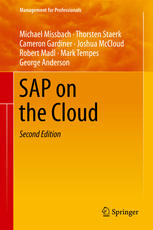

Most ebook files are in PDF format, so you can easily read them using various software such as Foxit Reader or directly on the Google Chrome browser.
Some ebook files are released by publishers in other formats such as .awz, .mobi, .epub, .fb2, etc. You may need to install specific software to read these formats on mobile/PC, such as Calibre.
Please read the tutorial at this link: https://ebookbell.com/faq
We offer FREE conversion to the popular formats you request; however, this may take some time. Therefore, right after payment, please email us, and we will try to provide the service as quickly as possible.
For some exceptional file formats or broken links (if any), please refrain from opening any disputes. Instead, email us first, and we will try to assist within a maximum of 6 hours.
EbookBell Team

4.3
48 reviewsThis book offers a comprehensive guide to implementing SAP and HANA on private, public and hybrid clouds. Cloud computing has transformed the way organizations run their IT infrastructures: the shift from legacy monolithic mainframes and UNIX platforms to cloud based infrastructures offering ubiquitous access to critical information, elastic provisioning and drastic cost savings has made cloud an essential part of every organization’s business strategy. Cloud based services have evolved from simple file sharing, email and messaging utilities in the past, to the current situation, where their improved technical capabilities and SLAs make running mission-critical applications such as SAP possible. However, IT professionals must take due care when deploying SAP in a public, private or hybrid cloud environment. As a foundation for core business operations, SAP cloud deployments must satisfy stringent requirements concerning their performance, scale and security, while delivering measurable improvements in IT efficiency and cost savings. The 2nd edition of “SAP on the Cloud” continues the work of its successful predecessor released in 2013, providing updated guidance for deploying SAP in public, private and hybrid clouds. To do so, it discusses the technical requirements and considerations necessary for IT professionals to successfully implement SAP software in a cloud environment, including best-practice architectures for IaaS, PaaS and SaaS deployments. The section on SAP’s in-memory database HANA has been significantly extended to cover Suite on HANA (SoH) and the different incarnations of HANA Enterprise Cloud (HEC) and Tailored Datacenter Integration (TDI). As cyber threats are a significant concern, it also explores appropriate security models for defending SAP cloud deployments against modern and sophisticated attacks. The reader will gain the insights needed to understand the respective benefits and drawbacks of various deployment models and how SAP on the cloud can be used to deliver IT efficiency and cost-savings in a secure and agile manner.